
To the world bread daythe Cooking Guide takes your doubts into consideration how to make perfect homemade bread. Whether it’s sweet or savory, plain or stuffed, daily bread is always special. And the gastronome Pedro Calvo helps you tips and tricks so as not to make mistakes when you make your own bread at home.
In this game of questions and answers, the expert explains everything: from the choice of ingredients and preparation to the time of cooking and how to store everything so that everything comes out without errors. With this help, making the perfect homemade bread will be super easy! Come on?
1. My dough is soft and does not come off your hands. How do I make it stronger?
The right point of the dough is very important when making homemade bread. “The soft dough means that it is very hydrated. But the dough that sticks to the hand does not mean that it is wrong and very hydrated! For the dough not to stick to the hand, reduce the amount of water in the recipe”, explains Pedro .
2. Is there a difference between kneading bread by hand and kneading with the aid of equipment?

“No,” says the gastronome. “Any bread can be made by hand, kneader or mixer [equipamento profissional]. The most important thing is to develop gluten. Making homemade bread by hand takes more time than using a planetary mixer or a mixer, that’s the difference. “
3. Which is the best choice between wholemeal and white flour?
It all depends on each recipe. The expert adds that “wholemeal breads tend to be denser [pela farinha conter menos glúten] and rich in fiber “, while” white breads are soft and light “.
4. What is the difference between dry yeast and fresh yeast?
According to Pedro, the difference lies in the way they were produced. “The dry yeast is dehydrated, making it more concentrated and 3 times stronger. Therefore, the amount of dry yeast used in the dough must be less than the fresh one. For example: if the recipe calls for fresh yeast, but you only have the dry one, divide the weight of the yeast by three “, he specifies.
5. Why does the dough need to rest when making homemade bread?
“Each time the dough is handled it is necessary to let it rest because the gluten is elastic and needs to relax so as not to tear the dough or it does not ‘come back’ at the moment of modeling”, says the gastronome.
6. How do I know if my dough is leavened enough?
Pedro explains that the dough grows about 1.5 times its original size. “Another tip is to touch the bread and feel it soft [deve ficar com a marca do dedo no pão após o toque]”, He adds.
7. Why is my bread baked on the outside but raw on the inside?
When preparing perfect homemade bread, pay attention to the high temperature of the oven: “For sweet breads, use the oven at about 150/160 ° C. For breads with crust, use at about 180 ° C”.
8. Why is my bread hard and dry?
Pedro says that “the flour is responsible for the recipe”. As in the whole recipe, normally the rest of the ingredients are calculated based on the weight of the flour. “What can make bread hard and dry is the lack of technique, such as not developing the gluten well in the dough, or putting little liquid in the dough,” he explains. Among the ingredients that help in the softness of the bread are fats (butter, olive oil or oil) and sugar.
9. After all, what is gluten?
It is a protein found in the grain of wheat, rye, oats and other grains. It is found in white and wholemeal flours, commonly used in the production of various foods, including bread.
10. Do the breads have an expiration date?
Yes, although it is difficult to define a standard duration period. According to Pedro, “the shelf life may decrease if the bread is wetter or more stuffed, or if it is handled in an unhygienic place. To ensure that the bread lasts longer, it is best to store it in a plastic bag in the refrigerator. It should last at least 5 days “. Remember: Stuffed breads last much shorter because they have a moist filling.
11. Is the preparation method the same for sweet and savory breads?
Pedro explains that the procedure is basically the same, but the difference lies in the preparation of the sweet dough, which must begin with the “sponge” technique. “If the dough has 15% or more sugar, or 25% or more fat, you should make a sponge cake with some of the wheat flour, water and all the yeast from the recipe,” he explains. .
In sweet recipes, this is the first step. First mix the flour, water, yeast and wait about 15 to 20 minutes to act. Then just add the other ingredients required in the recipe.
12. Does the temperature of the ingredients affect the final result?
“Yes,” says Peter. “The dough must come out with a temperature between 23 ° C and 25 ° C after mixing the ingredients. If it comes out at a high temperature, the bread starts to ferment too quickly. Using any hot liquid accelerates fermentation, which it is not good for bread, because it loses quality, aroma and flavor, so the water must be cold (about 5 ° C) “.
Source: Pedro Calvo, partner-owner of the Santo Pão bakery, in São Paulo-SP, graduated in Gastronomy from the Universidade Anhembi Morumbi and Master Baker from SENAC-SP
+The best content in your email for free. Choose your favorite Earth Newsletter. Click here!
Source: Terra
Benjamin Smith is a fashion journalist and author at Gossipify, known for his coverage of the latest fashion trends and industry insights. He writes about clothing, shoes, accessories, and runway shows, providing in-depth analysis and unique perspectives. He’s respected for his ability to spot emerging designers and trends, and for providing practical fashion advice to readers.







